|
Working with LoTW
If you have already exported your log previously to LoTW, then it is not
necessary or desirable to upload your entire log again, Winlog32 takes care of
tracking uploaded QSO, but in the new process, this is different from the
previous function, making it necessary to reset the starting point for the next
QSO export, if you are exporting your log for the very first time to LoTW then
you can skip this bit and go direct to HERE otherwise you will need to set the
start point for your next upload (this time only).
The file handling procedure take place in the ..Winlog32\OUTPUT folder, to save
confusion it would be a very good idea to delete the contents of this folder to
save unnecessary confusion later.
Once set-up, Winlog32 will track the correct export point so that duplicated QSO
uploads are unlikely.
First log-on to the LoTW web site
https://p1k.arrl.org/lotwuser/default enter your user name and password
Click on "YOUR QSOS" and then "MOST RECENT QSOS"
MOST RECENT QSOS are by default sorted in Date/Time order, inspect the last
(top) QSO in the list, if this looks like the last QSO you have uploaded then
proceed, if it is not, then it is possible that the sort order may need
changing, go back to the "YOUR QSOS" page, - set: SORT ORDER = "Receipt Date"
with DECENDING checked and SUBMIT. N.B. SUBMIT button - not MOST RECENT QSOS button.
Make a note of the last QSO uploaded, Callsign, Date and Time you will need
these to start the upload position of your log ready for the next QSOs to be exported.
Go back to Winlog32, in the SEARCH CALLSIGN window, enter the last QSO callsign
uploaded from above.
In the Search Page, if there are more than one QSO returned for that callsign,
select the correct one using the above Date/Time criteria
Double click the QSO so that it appears in the Log edit area.
Open the LoTW Manager window
menu/File/LoTW Manager
Click the EXPORT toolbar button.
Double-click the start QSONO input box as below, this will grab the NEXT
QSO in the log as the start point , see example below.
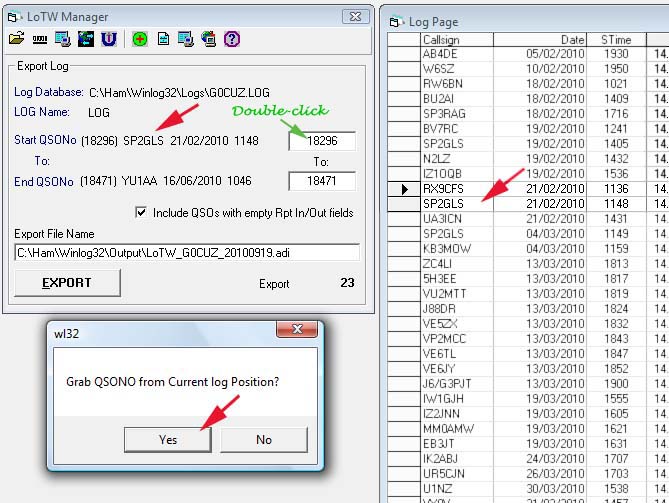
NOTES:
QSONo is a unique number assigned to a QSO record
during the logging process, this number starts at 1 and increments as QSOs are
entered into the log, it may have no relationship to the number of QSOs in your
log, numbers are added consequetivly, but they may not be contiguous, so it is
quite normal for numbers to be missing.
Brief details of the relative QSO are indicated to the left
of the number.
End QSONO will normally be the last QSO entered into
the log, the start and end QSONo numbers in the boxes can be changed manually,
but under normal circumstances this will not be required.
Export file Name: this is automatically set and should not be changed,
likewise the ..\Winlog32\OUTPUT folder MUST be used throughout for correct file
manipulation and automatic function.
LoTW MANAGER

Open LoTW Manager window.
 # #
Click on first toolbar button 'Export'

Start QSONo will be selected depending on last export QSO range, if this was not
previously saved, first QSO in the Log will be selected.
End QSONo will be the last QSO entered into the Log.
Option 'Include QSOs with empty report' can be checked when such valid QSOs
exist in the Log, Winlog32 does allow invalid QSOs to be logged whereby
'ReportIn' and ReportOut' fields are left blank thus indicating an invalid contact,
in which case this should be un-checked.
Click on EXPORT button to export the log file as ADIF.
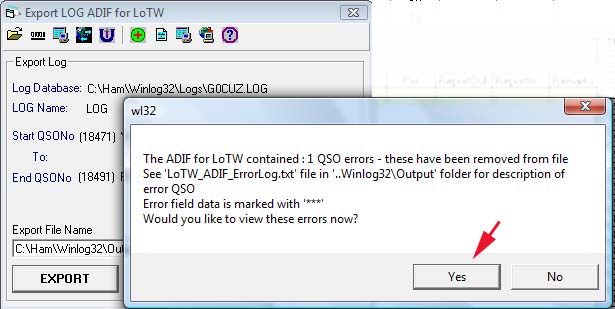
QSOs may be rejected where the basic necessary data is incorrect or missing in
the Log.
The minimum QSO data requirement for LoTW is Callsign; Date; Time; Band; Mode.
Errornous QSO will be removed from the exported file and added to the error log,
these errors must be corrected before continuing, otherwise these QSO may never
be uploaded to LoTW.

View the error log and use 'Search Callsign' to locate the individual QSO, the
field where the error occurs is marked in the error log with ****, edit this
field in your Log to correct the error, when all reported errors have been
corrected, close and re-open the LoTW Manager window and EXPORT again until no
errors are reported.
SIGN
Toolbar button #2.
The file already exported will be pre-selected
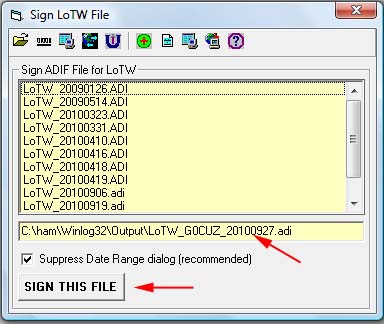
The option 'Suppress Date Range dialog' should be checked for normal operation.
Click on the 'SIGN THIS FILE' button.
This will start the TQSL file signing utility.
Select the 'Station Location' for your log - if this is not already set-up - it
must be done now.
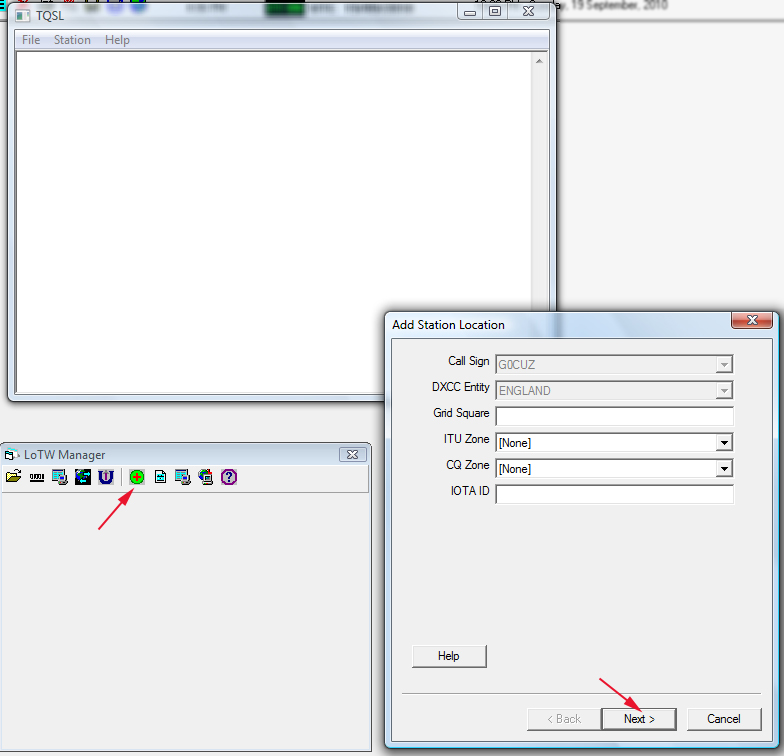
NOTES:
'Station Location' for the TQSL Utility is not the same facility as 'Station
Location' in Winlog32.
The result of the signing will be displayed by the TQSL utility, and errors
reported MUST be corrected before continuing, otherwise the QSO will be rejected
by LoTW.

Errors are typically unrecognised digital modes, these will need mapping in the
TQSL Utility or you may wish to ge the config fle in TQSL (see later)
To map modes in TQSL - Open the TQSL Utility and from TQSL menu File/Preferences, select
tab ADIF Modes, if you require further help with this see TQSL documentation -
Menu/Help - Preferences - ADIF Modes.
If you would prefer to change the TQSL configuration see also - Notes on .tq6 config settings.
If errors were present, go back and sign the file again until no further errors are
reported, then close the TQSL Utility window and return to LoTW Manager.
NOTES:
The digitaly signed file will have suffix .tq8, this file
is in binary format.
UPLOAD
Toolbar button #3, Upoload .tq8 file to LoTW.
Here the file can be uploaded directly to the LoTW server, the file for
upload is automatically set to the last signed file.
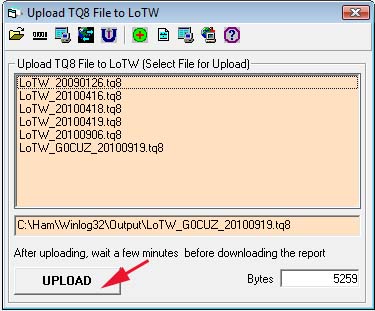
Click on UPLOAD.
Await confirmation response.
If the file has been 'Accepted' by the LoTW server, the correspondingly produced
.adi and .tq8 files are deleted automatically.
If the file was not accepted or there was any other error, the files will be
intact for investigation.
The file has now been loaded onto the LoTW server for processing, this can take
a few minutes, so it is best to wait before requesting a QSL report.
DOWNLOAD
Toolbar button #4, Request report from LoTW server.
The matching QSL data file from LoTW can be used to update your Log.

The 'Download QSL after Date' option should be checked, as this will restrict the downloaded
report to QSL received after that date, this will reduce file size and greatly speed up processing when updating the log.
This date is generated/updated when updating the log with the present report file.
If the Date is blank or 'Download QSL after Date' is no checked, the whole QSL report will be downloaded.
Download only for [callsign] restricts the QSL data for that callsign,
this is only necessary where you have multiple Logs and callsigns.
UPDATE
Toolbar button #5, update the log from the LoTW QSL report.
The QSL report file may contain additional data of interest supplied by the
QSLing station like IOTA and Grid locator
The 'Check IOTA from report' option will check any IOTA contained in the report
to see if it is new or unconfirmed, if it is new it will be added to the Remarks
field and provoke an IOTA update routine.
The 'Add Grid from report' works similar except that grids in the report will be
added to the Remarks field regardless of worked/confirmed status, grids are only
added to VHF/UHF QSOs.
'Add US County', most U.S. stations have included their State and County pairings,
if this is of interest, then enabling this option will add the U.S. State and County
to the Log Remarks field, and also
update both WAS and USCH databases. (Winlog32 versions > 2025)

If you have a large file to process, the AUTO option will skip the 'Update QSO'
prompt.
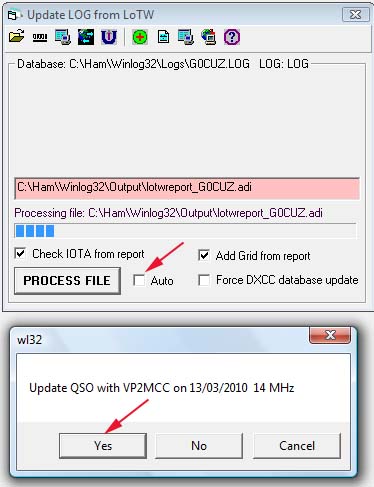
After selecting your options Click on PROCESS FILE button to begin the update routines.
The update routine will check DXCC, IOTA and Grid locator for worked/confirmed
status'
'Force DXCC database update' will update DXCC database from the LoTW QSL report
regardless of current status, this option will not normally be enabled.

After the processing is complete, a summary of the update activity will appear.
Last QSL downloaded date is significant - this is the date that will be added to
restrict future QSL downloads in Download - 'Request Report..', this restricts
QSO/QSL only to QSL recieved after that date thus relieving the the QSL
processing.
Error QSO/QSL occuring during processing will be reported together with error,
if you are using multiple logs this may ocur when 'Download only for [callsign]'
was not enabled and you have multiple accounts.
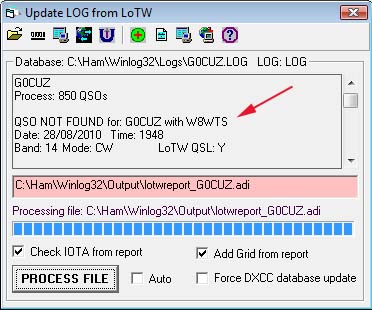
Errors in 'QSO NOT FOUND' may also occur if the log you are trying to update
does not contain all the QSOs you have previously uploaded to LoTW or the QSOs have later been edited in the Log.
NOTES:
The processing checks the lotw report QSL and tries to
match them with Log QSO data, the matching criteria is Date; Time; Frequency Band, N.B. Mode is not part of the matching process
'not found' thus may result where any of these were changed in the interim time
between export/upload and download.
|